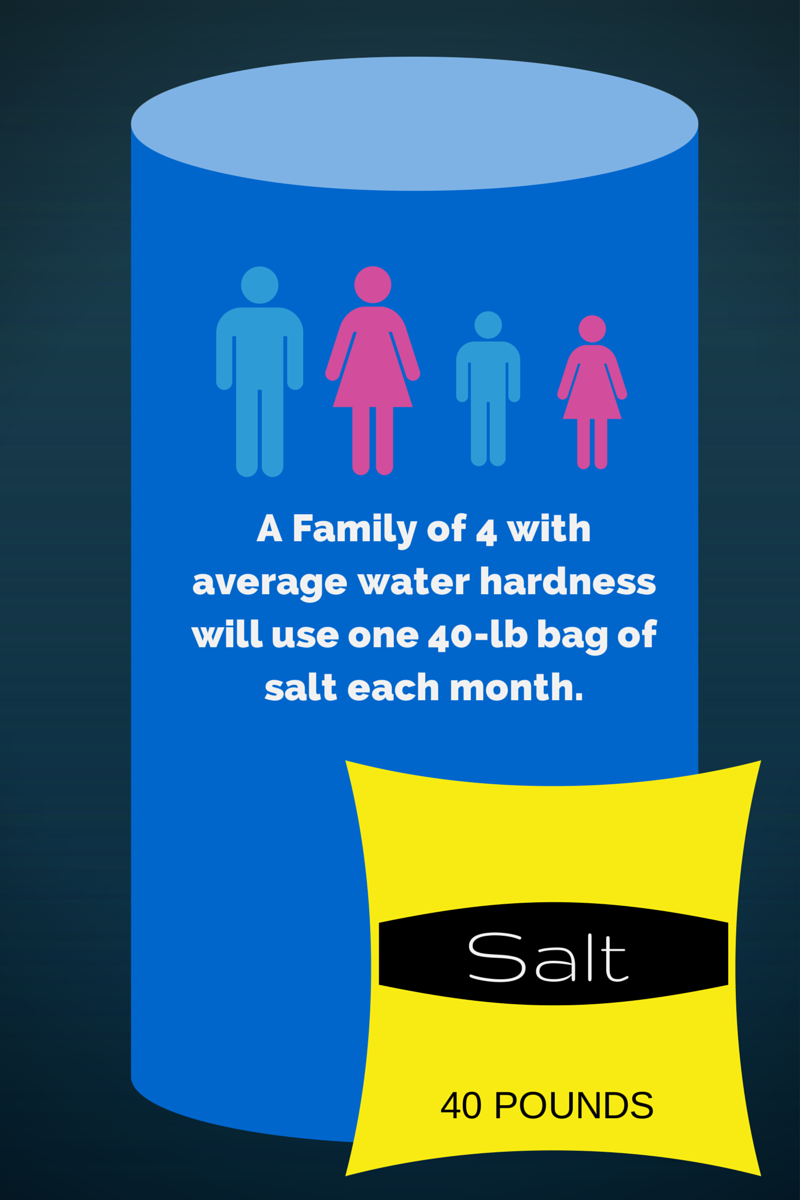Perhaps you recently added salt to your softener’s brine tank yet it already looks like it’s time to add more. Now you’re wondering if your softener is working properly and how much salt an average softener should go through?
If you own a water softener, you’ll want to check your softener’s brine tank a least once each month to make sure you have enough salt. Most water treatment experts recommend that the level of salt should be three to four inches above the water level in the brine tank.
How often Should You Add Salt to the Brine Tank?
How much salt you’ll need to add will depend on the level of “hardness” in your water and the quantity of water your household consumes. Industry standard is that the average family of four with hard water (7-10 grains per gallon hardness level) will use about 9 to 10 pounds of salt each week or one 40-lb bag of salt each month.
Having mentioned the industry standard for salt usage with a water softener, it is important to note that most water softening systems in the industry can also be adjusted to use more or less salt on a monthly basis.
The amount of salt used for each regeneration cycle will determine the amount of gallons of water that can be softened before needing to regenerate.
So there is an inherent trade off:
1) increase the amount of salt each regeneration cylce and decrease the amount of regeneration cycles over time or…
2) decrease the amount of salt each regeneration cycle but increase the amount of regeneration cycles over time.
Salt Usage Increase
You may find that you’re going through more than the “one-a-month” bag of salt…
- If you have a larger capacity water softening system than the industry standard of 9″ diameter softening tank
- If your water is very hard (above 10 grains per gallon hardness)
- If your water has an iron level over two parts per million
- If your family size has changed. A larger family generally consumes more water which will cause your softener to regenerate more frequently, and thus use more salt.
- If your local water treatment specialist has adjusted your valve settings for the softener to regenerate more often and thus consume more salt.
- If your area is experiencing drought conditions, your water treatment professional may adjust your softener’s valve settings to conserve water, but use more salt. (This adjustment could cause your water to taste more salty right after the system regenerates, so talk this over with your water specialist).
Fortunately, the valve control on many water softeners and conditioners will do all of the calculations for you regarding when to regenerate. Then you’ll just need add more salt as it is used up. Many homeowners buy and add 120 pounds (three 40-lb bags) of salt at a time so they only have to add salt once every three months.
Check with your local water specialist for specifics on how much salt your system is using and how often to purchase salt.
Why Does the Salt in my Brine Tank Seem to Dissolve so Quickly?
You may notice a difference in how quickly the salt in the brine tank seems to dissolve. This could be because you’ve changed the type of salt you’re using. For example, if you’ve gone from solar to evaporative pellets, some salt types are denser than others. Talk over the type of salt you’re using with your water treatment specialist or check your system’s owner’s manual as settings can be adjusted per type of salt used. At WaterTech, we recommend using either potassium chloride or evaporated water softener salt pellets with a purity rate of 99.5 percent.
What if I Forget to Add Salt?
If you forget to check salt levels in the brine tank and run out, you simply won’t have soft water. Suddenly seeing spots on your glass shower door might be a dead give away. If you do run out of salt, keep in mind that it may take 2-3 days to get softened water throughout the house again (it usually takes more than one regeneration cycle). To guarantee a satisfactory production of softened water, the salt level should be kept at least half-full in the brine tank at all times.
WaterTech’s Reionator Water Conditioning System Keeps it Simple
WaterTech’s Reionator has a five-button “Triton” metered valve. This valve is automatically set to “consumption mode” which means that it keeps track of how much water is being used by the household, and even anticipates consumption.
For example, if you’re close to needing regeneration, the meter will recognize if the time is late in the evening and the system will go ahead and regenerate overnight to make sure there’s enough softened water for morning kitchen and showering needs. It’s so smart, it can anticipate your family’s water usage which makes it 40 percent more efficient than the competition in water and salt conservation.
Ask your local WaterTech dealer to tell you more about the Reionator Water Conditioning System.





